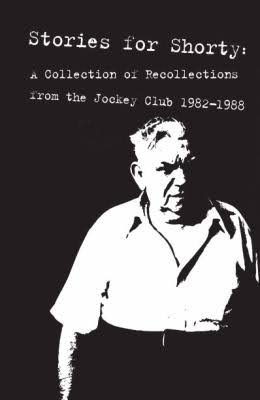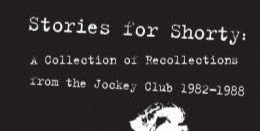Urban Appalachian culture consists of many things, and much of which is not so obvious. Appalachians in greater Cincinnati have had a hand in every aspect of our culture, and so the Urban Appalachian Community Coalition keeps our eyes and ears open for the unlikely. It may come as a surprise to many that greater Cincinnati became something of an epicenter of punk rock in the 1980s, and one of the reasons for this is the presence of the old Jockey Club in Newport, Kentucky (now the site of Wooden Cask Brewing Company) that was under the proprietorship of Hallman “Shorty” Mincey and his brother Hayne “Tiny” Mincey who were originally from Lumpkin County in the Appalachian region of North Georgia.
How Shorty and Tiny came to run the premier local punk rock destination in the 1980s is about as unlikely a story as possible. It is not known how the Mincey brothers made their way to Northern Kentucky. Betsy Young of Aurore Press is currently researching a history of the Jockey Club and a biographical sketch of Shorty and Tiny for a coffee table book that will include flyers from shows at the old Jockey Club. The club closed its doors in 1989 when Shorty sold the property. Young explained that based on what she discovered, Shorty “went while the getting was good in Newport, Kentucky. Their father was murdered when Shorty was six years old, and life in Georgia did not hold much promise.” Like so many Appalachians, the Mincey brothers left for urban possibilities to escape a place of poverty and hardship.
The possibilities that may have been up north drew them from home, and this is a familiar story. The migration from rural Appalachia to places like Campbell County, Kentucky was driven by many forces. The possibility for better economic opportunities in the north brough countless Appalachian migrants to Newport, Kentucky.

Shorty first purchased what was known as the Jockey Club some time in the 1950s. The original Jockey Club was right on the riverfront. It was a rough place at the time. Betsy Young told me that “Shorty apparently shot someone one night when a man started waving a pistol around. The man lived, and Shorty was never prosecuted.” The original Jockey Club site closed when the county bought everything under eminent domain to build the flood walls along the river. Shorty and Tiny then purchased the old Flamingo Club at 633 York Street. This had been a notorious mob joint, although the original owners billed it as a “carpet joint,” a more upscale club that offered live music and better odds at the gambling tables. Remember, this all took place during the time that Newport, Kentucky was deeply influenced by organized crime.
Under the new owners, the Flamingo Club was re-named as the Jockey Club. Still a rough and seedy place, Shorty and Tiny booked local cover bands until they were approached in 1982 by Billy “Blank” Leist and “Handsome Clem” Carpenter about booking punk bands. Punk was a new thing at this time, and it was not necessarily a welcome thing for many people. By 1982, punk culture had already gained a reputation for disruption and lawlessness. Nevertheless, Shorty’s only concern was that the bands would bring people into the bar to drink. The Jockey Club became the place for national and international punk acts to play in greater Cincinnati. I saw many shows at the Jockey Club. The Damned in 1986 is one of the most memorable, but the countless local bands made up of musicians that still enrich local music Cincinnati were among the shows that made the Jockey Club a singular destination.
Core Member Pauletta Hansel’s husband Owen Cramer, who was a VISTA volunteer before and during the Jockey Club’s early punk days, waxed poetic about the place: “From 1978 to 1983 I lived two blocks away from the Jockey Club. Even before it became a punk palace, it was a destination. The building spoke of its literal and figurative apocalyptic past. You’d walk in the front doors to a cramped empty area that might have had a small bar at one time; on each side were two double doors that were the gateway to the decrepit past, leading into a cavernous room too long, too wide and too tall to have served a useful purpose since the Eisenhower administration. Below the rotting ceiling tiles and moldy wood panels, white and brown checkered tiles were laid out to the horizon. The contrast of the white and brown tiles was reflected in the contrast between Shorty, who was a stumpy man, and Tiny, who had no equal in physical size. Any time of the day there were a small number of locals sitting at the linoleum table drinking their PBRs. You might wonder how the owners managed to keep the lights on or the plumbing working, until you realized they didn’t. The Men’s Room was the most foul and dysfunctional piece of real estate in the tristate area. Yet somehow, within the decay there was beauty.”
Owen paused here to quote from Robert Frost: “’The witch that came (the withered hag) / To wash the steps with pail and rag / Was once the beauty Abishag,’” before concluding: “Forty years later people will tell me about the memorable time when I led them into The Jockey Club for a true Newport experience.”
Shorty’s bottom line with selling drinks, and an absolutely fearless approach to music, set the tone for how the Jockey Club would function for the rest of its existence. This is only the briefest thumbnail of wild history of how a man from Appalachian Georgia managed to create the space for punk rock in our region of the country. Betsy Young’s work on this history will appear in the forthcoming book from Aurore Press. Aurore Press has already published a collection of memories from the Jockey Club called Stories for Shorty.
Aurore Press has published numerous poets and writers from greater Cincinnati and beyond. Betsy Young, her husband Chuck Byrd, and their daughter Aurore Byrd make up the nucleus of a family of writers, poets, and artists, and I emphasize the word family here. Anyone who has ever been a part of this project knows that they are welcomed as part of the “Aurore Press Family.” Aurore Press has published local poets Mark Flanigan, Nik Barrows, and Matt Hart. They have also brought us the work of Alx Johns from Athens, Georgia. Not a group to shy away from taking chances, Aurore Press states on their masthead that they are “The place for dissenting views in Cincinnati.”
Punk rock may not be everyone’s cup of tea, but the impact of this movement cannot be denied or relegated to a blip on the radar of pop culture. The legacy of punk and those who made it bears on much of what exists today in just about every dimension of art, politics, and culture. That Cincinnati became one of the central sites for punk culture in the 1980s is due in large part to an urban Appalachian man whose ambitions were not all that lofty, but whose legacy reaches well beyond our region. I outlined some of the cultural history of punk in the Midwest in an essay entitled “Punk Rock in Pence Country.” Shorty and Tiny Mincey were just two displaced Appalachian boys who worked to make their lives a little better in a northern city. But they definitely ended up offering one of the wildest versions of what the Urban Appalachian Community Coalition describes as cultural and artistic expressions of who we are.
More information on Aurore Press books and events can be found here: https://aurorepress.com/.
To read about punk rock in the Midwest, follow this link: https://www.theculturecrush.com/punk-rock-in-pence-country.
Mike Templeton is a writer, independent scholar, barista, cook, guitar player, and accidental jack-of-all-trades. Check out his profile in UACC’s new Cultural Directory. He lives in downtown Cincinnati with his wife who is a talented photographer. They spend their free time walking around the city snapping photos. She looks up at that the grandeur of the city, while Mike always seems to be staring at the ground.

